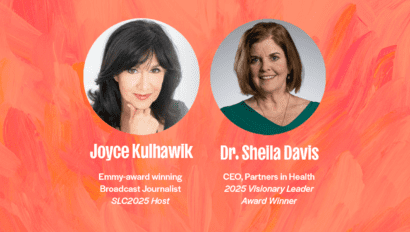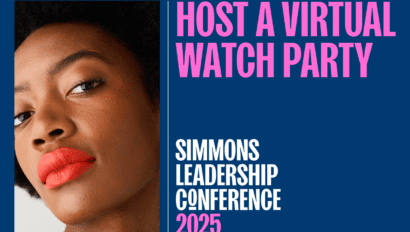Research & Insights
Conversations about Courage and Connection in a Hybrid World
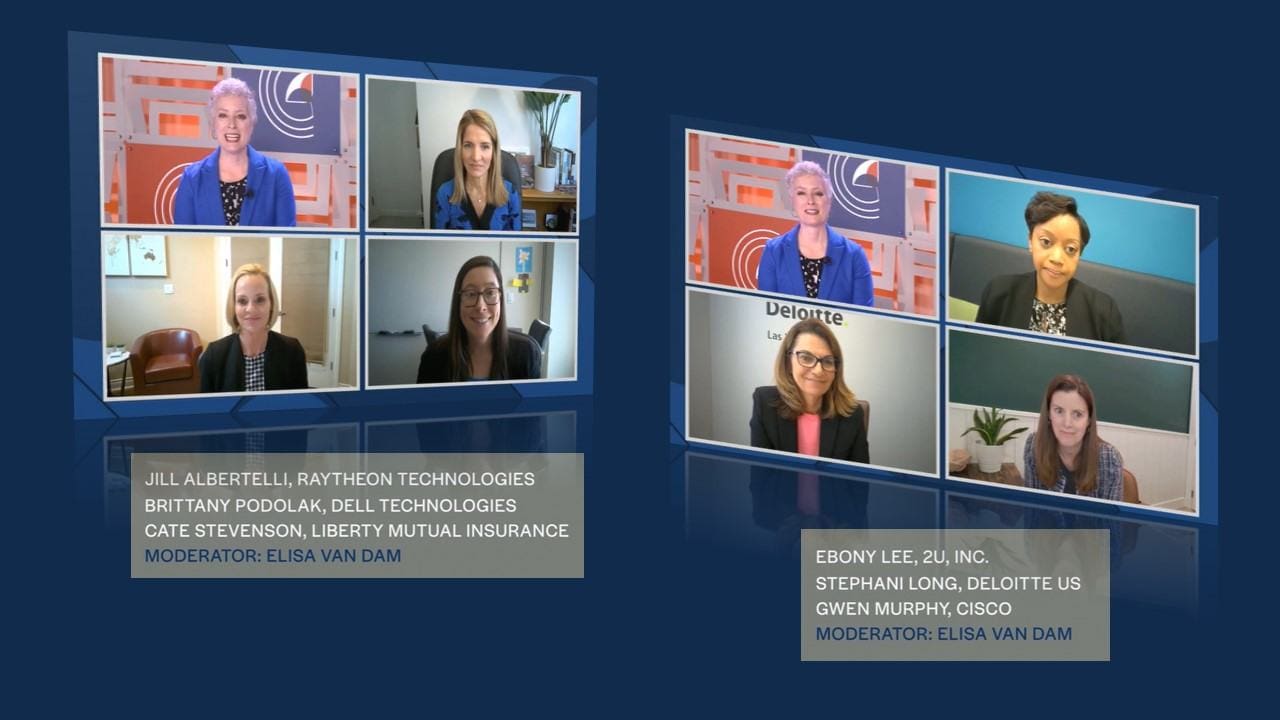
Top Women Executives Discuss Courage and Connection in the Workplace
Top women executives participated in thought-provoking panels at the 43rd Simmons Leadership Conference and discussed steps they – and their organizations – are taking to cultivate courage and connection, particularly in a hybrid work environment.
Elisa van Dam, Vice President of Allyship and Inclusion for the Simmons University Institute for Inclusive Leadership, moderated the sessions, posing compelling questions to the panelists.
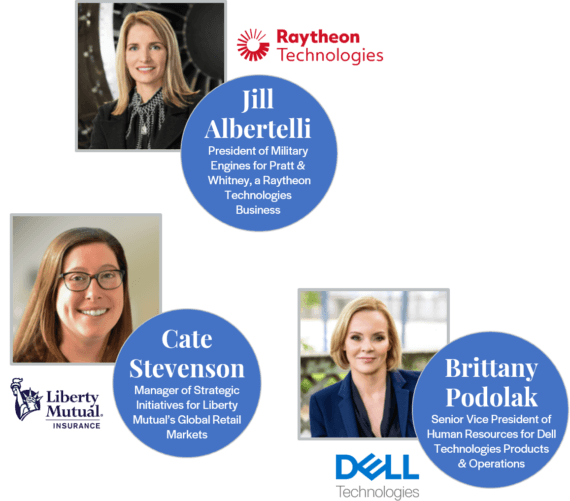 Morning Business Panel
Morning Business Panel
Courage
Jill Albertelli, Brittany Podolak, and Cate Stevenson offered insights into how they exercise their courage muscles and foster inclusivity within their organizations. They agreed that being intentional, mindful, and focusing on outcomes has helped them to be courageous and successful leaders.
How are your courage muscles feeling right now?
“When I think about exercising my courage muscles, I start with the end in mind. What is that vision I’m trying to create? And courage to me is pursuing that great outcome. Even though it may not be easy, it may not be convenient, it’s understanding what that outcome is and choosing that path over what might be convenient or what might be more comfortable.”—Brittany Podolak
“Courage to me means sometimes changing your goal or your outcome or where you’re headed and being really comfortable with doing that.”—Cate Stevenson
“I see courage in really challenging yourself to have strength in the face of adversity.”—Jill Albertelli
How is your company enabling you to feel courageous?
“[At Raytheon], we do quite a bit of leadership training. We give people space to have very open conversations. When I start a meeting, I set the stage and say, ‘This is a safe space. Whether it is a problem, an issue, a challenge, or an opportunity, let’s get it on the table and let’s talk through it as a team.’ We see that type of culture throughout our company.”—Jill Albertelli
“We divine work as not a place or time, but an outcome. This really opens things up for people and gives them the opportunity to exercise personal agency, and the result is they enjoy greater job satisfaction.”—Brittany Podolak
After rising to the senior executive position she had aspired to, Cate realized the timing wasn’t right for her personally because she was dealing with depression and anxiety, and she took that information to her leader, who supported her decision.
“At Liberty [Mutual], they put people first. I feel like I have a whole tribe behind me. It was one of the most courageous things I’ve ever done, but I didn’t realize it was courageous at the time.”—Cate Stevenson
What have you learned over the past few years that will bring you to the future?
“It’s about taking the time to do things for yourself to remain passionate about what we do every single day, but it’s also about making time for the employees, making sure you’re still having that connective conversation. It might be a little different if it’s through video, but that doesn’t mean you don’t have it.”—Jill Albertelli
How can you be courageous and speak out in a hybrid work environment?
“On virtual calls, it’s important that we create a level playing field. Tell people, ‘I expect you to challenge me.’ Recognize people when they do that. Being intentional matters. Long gone are the days of shooting from the hip. My advice is to be very intentional, very planful, and very deliberate with your words.”—Brittany Podolak
What is the best way to question someone else’s point of view without being disagreeable?
“Make sure you’re actively listening and giving the other person time to speak about their viewpoint, and then say, ‘Maybe I was thinking about it in a different way.’ It conveys that ‘I was listening to you, and I believe I heard what you said.’ The phraseology that we use and being purposeful with our words promotes a positive approach. But as women, sometimes we tend to back off because we don’t have the courage or we fear that we’ll be seen as arguing as opposed to bringing forward our opinion.”—Jill Albertelli
What do you think we need to do in order to prevent the hybrid work environment from being a hindrance to women in the workforce rather than an asset to their career?
“We need to deploy new ways of working and rethink how we do meetings, how we give people access to information so being in the office doesn’t create some unfair advantage. In this global environment, it comes down to being purposeful, being mindful, projecting inclusion. Being flexible and inclusive makes everyone successful.”—Brittany Podolak
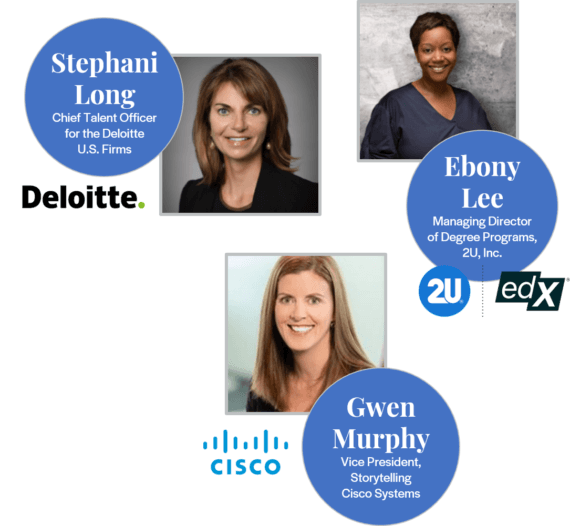 Afternoon Panel Discussion
Afternoon Panel Discussion
Ebony Lee, Stephani Long, and Gwen Murphy shared initiatives their companies have implemented to facilitate connection among employees and what they are doing as leaders to encourage connection. They each noted that it’s critical to be intentional and flexible when providing opportunities for connection.
How are you feeling about connection over the past three years?
“My success doesn’t happen unless I’m able to cultivate connection with all of the people I work with directly and indirectly across the organization.”—Ebony Lee
“Cultivating connections is so important for each of us, for our own personal well-being, our health, our development, how we’re feeling day to day.”—Stephani Long
“When I think about cultivating connection, I think about leaning in to my natural curiosity about people, how they think, how things work. Whether it’s someone new or someone I’ve known for a long time, it’s about being open to the conversation, asking a lot of questions, listening well. This leads to deeper understanding of how you might be able to work together.”—Gwen Murphy
How is your business supporting your ability to connect?
“I have the benefit of working for a very relationship-based organization. At our core, Cisco supports people to bring their authentic selves to work, so creating strong connections comes naturally. It’s also encouraged to gain proximity to others who might identify differently than you do. Our culture, our processes, our focus is around true connection and a deeper understanding of everyone who works at our organization.”—Gwen Murphy
“We are proponents of business resource groups, which are employee-led groups where we bring people together who share common interests. We launched 2Q, which is for our LGBTQ+ community. We have a Black Engagement Network, a Women’s Alliance Network, and TuGente for LatinX employees. We continue to reinforce that we’re here for each other and provide opportunities to build strong connections.”—Ebony Lee
“We realized during the pandemic that people were a little afraid or concerned about getting into the office, how to commute, and how to connect with people, even if it wasn’t in the office. We’ve done everything from providing commuting allowances to help people get together to providing a productivity allowance to help people get the tools they need to make it more effective for them to see each other.”—Stephani Long
What do you predict will be the effects of Covid on connection?
“We have to be focused on how we balance flexibility in how we connect and how we create the sense of belonging. We’re going to have to have more intentionality in how we’re going to extend and create new ways of connecting and building that sense of belonging.”—Stephani Long
“There’s actually something really great about it. Things won’t go back to the way they were in that our ability to really forge connections is so much bigger. It’s without geographic boundaries that used to hinder us.”—Gwen Murphy
How are you thinking about virtual meeting fatigue while still maintaining connection and what are your thoughts about cameras?
“We have to be intentional and we should only have the meetings that we need to have. Let’s not overschedule, let’s be intentional about what requires us to be on a Zoom call. We also have to show different ways of engagement if people are not turning on the camera. Are they engaging in the chat? Is there a way to bring everyone into the conversation by asking questions?”—Ebony Lee
“We need to have cameras on for a good chunk of the time. When you know people well already, you don’t really need your camera on. When you’re trying to develop relationships early on and trying to build trust, you need to see each other and get to know each other.”—Stephani Long
How do we connect in a global world?
“Stagger time zones for meetings when you can so you can get most of the people on the call at the same time. When that’s not possible, you host a meeting twice so everyone gets the same information in the same way.”—Gwen Murphy



